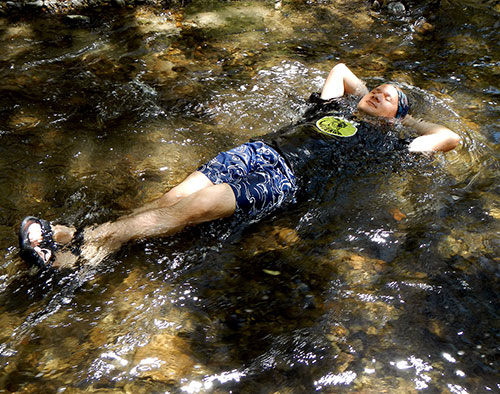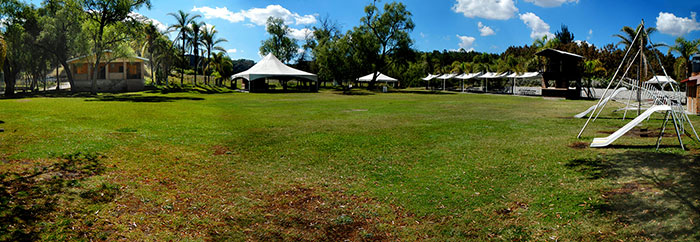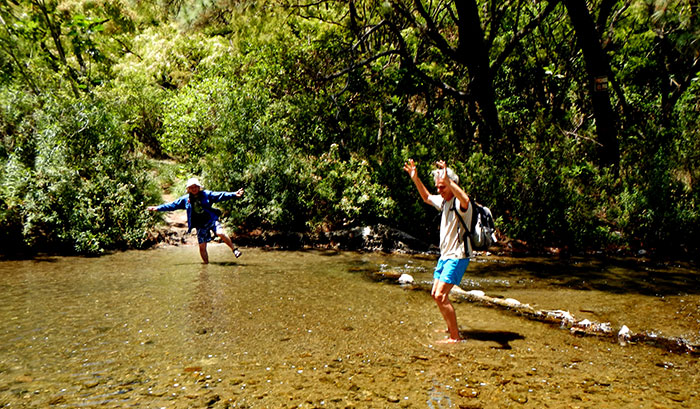|
By John Pint
 “I'm
interested in visiting Guava Beach in the Primavera Forest,” wrote
Albert Schmaedick from the shores of Lake Chapala, Mexico's biggest
lake. “Are there any good campgrounds nearby?” “I'm
interested in visiting Guava Beach in the Primavera Forest,” wrote
Albert Schmaedick from the shores of Lake Chapala, Mexico's biggest
lake. “Are there any good campgrounds nearby?”
That question was one I, too, wanted to investigate. Guava Beach is a
sandy clearing surrounded by guava trees on the west bank of El Río
Salado (the Salty River), the name given by locals to Río Caliente once
it cools down a bit. Next to the clearing there's a natural cold
spring, making Guava Beach “the perfect campground, with hot and cold
running water.”
“But how safe is it to camp there?” asked Albert. It´s a question
everyone seems to be asking these days.
To find the answer, Albert and I teamed up with outdoorsman Jorge
“Quercus” Robles, in a quest to find the closest “safe” camping area to
Guava Beach. We decided to approach the river from highway 70 which
passes through Ameca. A mere four kilometers from the paved
road we came to Balneario Río Salado where friendly caretaker Antonio
Meza welcomed us with open arms. “You want a safe camping site?” he
said. “¡Aquí está!
We have a big grassy area right here next to the Salty River where you
can pitch your tent. And, of course, we have toilets and hot showers
too, plus a guard and a locked gate.
This
wide
grassy area at Balneario Rio Salado is reserved for camping. The cost
is 75 pesos per person and includes the right to use clean bathrooms
and showers and to spend all the time you want soaking in the Salty
River.
The caretaker told us
their beautiful recreational area is open every day of the year and
assured me it is both peaceful and practically deserted on weekdays.
The cost for camping here is only 70 pesos for adults, 35 for children
and there's no charge at all for petting their tame boar, Chancho who
will gladly gobble up your leftover tortillas.
From the balneario, we drove south alongside the Salty River. This is a
favorite place for weekend picnickers, with lots of shade trees and
hundreds of good places to enjoy the Jacuzzi effect of the warm,
mineralized water bubbling through the rocks. For good reason my nieces
call it “the Rock-n-Roll River.”
A kilometer and a half from the balneario, the road ends. Here we
parked and set off on foot along a narrow trail that parallels the
river. After 550 meters, we came to a picturesque meadow between the
river and the nearby high, majestic cliffs. This is the place where a
German-speaking friend once exclaimed, “Oh mein Gott—this
place is really beautiful; it's magic!”
"It´s still here! Jorge "Quercus"
Robles and Albert Schmaedick jumping for joy while crossing the Salty
River.
We waded through the
shallow stream and stepped into the clearing, still nice and clean and
still surrounded by guava trees. At one end we found three tents
pitched and the owners told us this campsite was about as good as they
get. “We have shade, sand and hot water,” a young man told us, “and
just behind our tents there's a cold ojo de agua with
delicious, drinkable water.”
We joined this family for a soak in the river and then headed back
home. All went well until we reached the small stream we had crossed on
our way in. About halfway across, it became clear that something was
very wrong. That stream is normally no more than 20 centimeters deep,
but now water was splashing up and over the car's hood. “It's coming in
under the doors!” shouted Albert. In the back seat, I looked at my feet
and saw them disappear under a rising tide.
And that's when the car stalled. “The tailpipe must be under water,”
said Jorge Robles. “We have to get out and push—but don't open the
doors!”
Well, that
left only one way out: through the windows. Fortunately, all three of
us were wearing “water shoes.” I stuck my feet out the window and slid
into the river. The water came up to my pockets. What could have caused
this? Just at that moment, two cars arrived and a few minutes later
there were seven of us, nearly up to our waists in muddy water, trying
to push the car up and out of the river, grunting, sweating and
cursing. But the car barely moved. “Are you sure it's in neutral?”
shouted one of the men. “Sí,
está en neutral,” replied Jorge...and
then: “¡Caray... el
freno!” Yes, we had actually moved that car uphill
about two meters with the emergency brake on.
With the brake
off, we pushed it right out of the river and, to my surprise, the
engine caught in less than a minute. Unfortunately, bailing out Jorge's
car with coffee cups took a great deal longer, but in the end, it got
us back home, happy, if not dry.
How to get
there
Drive west
out of Guadalajara on “libre” Highway 15 for 25 kilometers and turn
southwest onto highway 70. After five kilometers you'll go under a
pedestrian overpass. Immediately, make a left turn into the little
town of Emiliano Zapata (N20.72017 W103.62735). You’ll see a fork in
the road straight ahead of you. Keep right and you’ll be on a winding
cobblestone road that will take you past the town plaza. Now the road
becomes dirt (good quality) and 300 meters past the plaza, you come to
a T where, again, you go right. Follow the main road south for 3.3
kilometers to Balneario Río Salado (N20.69207 W103.61322). Better use a
high-clearance vehicle! Guava Beach is two kilometers southeast of here
at N20.67922 W103.60266. This route is on Wikiloc.com under “GuadHikes
- Hwy 70 to Rio Salado.” Driving time from Guadalajara to the
balneario
is about one hour.
|

